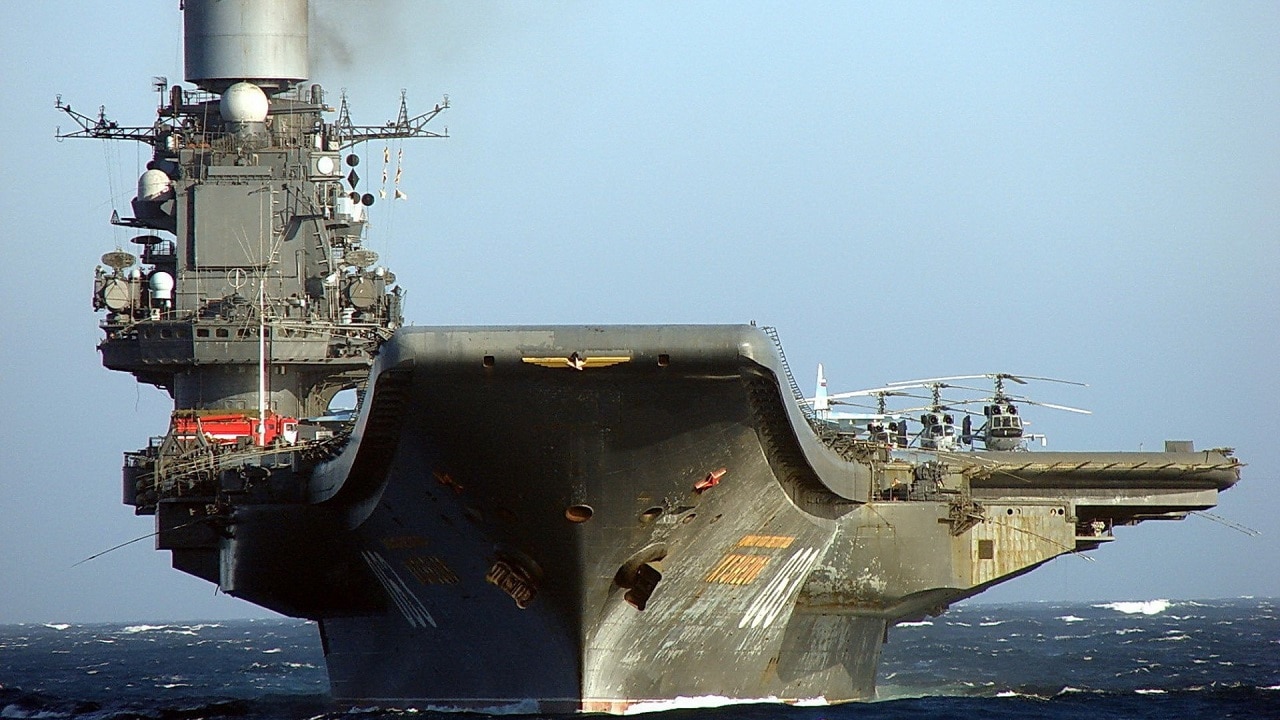Russia’s Admiral Kuznetsov Aircraft Carrier: Could It Still Serve? Russia’s sole aircraft carrier is reportedly set to finally leave dry dock in the coming weeks, state media reported earlier this month. Admiral Flota Sovetskogo Soyuza Kuznetsov, which has been undergoing a refit since July 2018, will move from dry dock to begin the next stage of her repairs.
(Subscribe to 19FortyFive‘s New YouTube Channel here.)
“The aircraft cruiser will be out of dry dock at the 35th ship repair plant on February 16-17,” an official at the Zvyozdochka Ship Repair Center told Tass.
The plant is a subsidiary of the state-owned United Shipbuilding Corporation (USC).
Admiral Kuznetsov entered dry dock last May, and work to repair and modernize the vessel has been ongoing since June. The warship began the process of leaving the dry dock facility in late December.
USC CEO Alexey Rakhmanov had previously told reporters that the aircraft carrier would be recommissioned in early 2024 after a major overhaul.
Admiral Kuznetsov Aircraft Carrier: Russia’s Sole Flattop
Originally developed at the tail end of the Cold War, the Admiral Flota Sovetskogo Soyuza Kuznetsov was actually designed as a “heavy aircraft-carrying cruiser” (TAVKR) to support and defend strategic missile-carrying submarines, surface ships, and naval missile-carrying aircraft of the Soviet Navy.
According to Navy Recognition, its main fixed-wing aircraft is the multi-role Sukhoi Su-33 and it also carries the Kamov Ka-27 and Kamov Ka-27S helicopters for anti-submarine warfare, search and rescue, and small transport.
Instead of catapults, the flight deck is fitted with a ski jump at the end of its bow for the take-off of fixed-wing aircraft, which results in a lower acceleration but clearance speed of only 120-140 km/h.
The ship’s armament also includes 12 long-range surface-to-surface anti-ship cruise missiles, giving it a “heavy aircraft-carrying missile cruiser” type designator. Unlike most Western naval ships that are powered by gas turbines or nuclear power, Admiral Kuznetsov is conventionally powered but relies on mazut as a fuel, which often leads to a visible trail of heavy black smoke.
As a result, at best, the flattop’s endurance was a mere 45 days, while Russia had few ports where the aircraft cruiser could operate year-round.
The carrier had been badly maintained due to funding issues during Moscow’s financial crisis of the late 1990s.
During deployments, the carrier was often escorted with tugs in case she were to break down.
An Odyssey of a Refit
Instead of retiring the carrier, Russia opted instead to refit the warship – but that hasn’t helped matters. And due to a number of debacles, the refit has taken years.
In November 2018, Admiral Kuznetsov was damaged when a 70-ton floating crane fell on the warship’s flight deck, which tragically killed one worker and injured four more.
It was just over a year later that a fire broke out in the engine room during a welding accident; and it resulted in the death of two, while 14 more suffered injuries from fire and smoke inhalation.
In addition, the actual drydock, which was vital to the repairs, was also damaged during a power outage, further delaying the refit.
Corruption has further contributed to the lack of progress on the carrier’s refit. In March 2021, Yevgeny Zudin, general director of Shipyard No. 10 in Polyarny, was arrested under suspicion of the theft of 45 million rubles (approximately $600,000) that had been allocated to the repair of the Russian Navy’s Northern Fleet flagship.
It appears that the efforts continue, and Admiral Flota Sovetskogo Soyuza Kuznetsov could finally be returned to service sometime next year.
MORE: Ukraine Needs M1 Abrams Tanks Now (But Will Have to Wait)
MORE: Joe Biden Won’t Send F-16 Fighters to Ukraine
MORE: Why Putin Should Fear the F-16 Fighter
MORE: Why Donald Trump Can’t Win in 2024
Author Experience and Expertise
A Senior Editor for 19FortyFive, Peter Suciu is a Michigan-based writer. He has contributed to more than four dozen magazines, newspapers, and websites with over 3,200 published pieces over a twenty-year career in journalism. He regularly writes about military hardware, firearms history, cybersecurity, politics, and international affairs. Peter is also a Contributing Writer for Forbes and Clearance Jobs. You can follow him on Twitter: @PeterSuciu.

